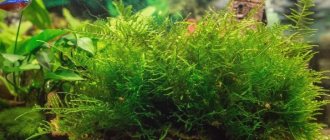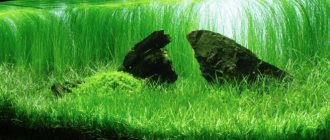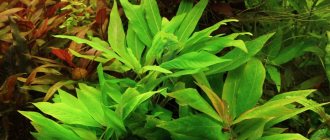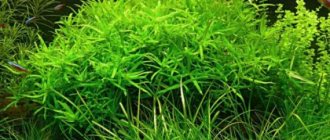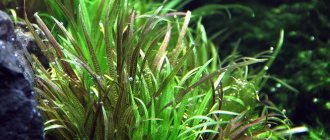4.8
(8)
When choosing vegetation for an aquarium, you need to take into account that it looks impressive and brings considerable benefits by purifying the water from harmful chemical compounds. Many plants cope with this task, including ammania. It is very popular among aquarists, because it has excellent decorative qualities and is easy to grow (it easily adapts to new living conditions).
Content:
The beautiful brown color of ammannia gracilis in cognac shades has allowed this plant to become the most popular among aquarists.
The growth of representatives of this species is influenced by intense lighting. If there is a lack of light, the leaves on the lower nodes, as a rule, darken (blackening occurs). Soil should only be used that is enriched with nutrients. The aquatic environment is soft at a temperature of about 24 C. Plants are planted in a ladder or separately, while only three to five stems are enough to form a group. The design of an aquarium decorated with representatives of this species looks simply magnificent. Return to the encyclopedia of aquarium plants
Azolla caroliniana, Azolla caroliniana, Azolla nilotica, Azolla filiculoides, Azolla pinnata, Acorus gramineus, Acorus calamus, Acrostichum, Aldrovanda rovanda vesiculosa) Alternanthera Alternanthera reineckii "Lilablattrig" Alternanthera reineckii "Rosablatting" Alternanthera reineckii Grunblattrig, Rotblattrig Alternanthera reineckii (Alternanthera reineckii) Alternanthera sessilis Ambulia (Limnophila sessiliflora)Ammania Senegalese (Ammannia senegalensis) Afzel's Anubias (Afzelii) Barter's Anubias (Anubias barteri var. barteri) Barter's Anubias smooth (Anubias barteri var. glabra) Barter's caladio-leaved Anubias (Anubias barteri var. caladiifolia) Barter's dwarf Anubias ( Anubias barteri var. . nana)Anubias barteri var. angustifolia)Giant Anubias (Anubias gigantea)Graceful Anubias (Anubias gracilis)Gillet's Anubias (Anubias gilletii)Spear-shaped Anubias (Anubias hastifolia)Pinera's Anubias (Anubias pynaertii)Anubias heterophylla (Aponogeton) abyssinicus))Aponogeton bernierianus ) Boivin's Aponogeton (Aponogeton boivinianus) Double-eared Aponogeton (Aponogeton distachyos) Aponogeton Decaryi (Aponogeton decaryi) Rigid-leaved Aponogeton (Aponogeton rigidifolius) Viviparous Aponogeton (Aponogeton undulatus) Capuroni's Aponogeton (Aponogeton capuronii) curly "Compact" (Aponogeton crispus "Kompakt")Aponogeton curly (Aponogeton crispus) Aponogeton crispus x rigidifolius Aponogeton longiplumulosus Aponogeton Loriae Aponogeton madagascariensis Robinson's nogeton (Aponogeton robinsonii)Aponogeton tenuispicatus Elongated Aponogeton (Aponogeton elongatus) Ulva-shaped Aponogeton, “sea lettuce” (Aponogeton ulvaceus) Jacobsen’s Aponogeton (Aponogeton jacobsenii)
Keeping in an aquarium
Ammania bonsai is a rather whimsical and fragile plant in terms of its maintenance and breeding, so it is better to care for it by an experienced and responsible aquarium owner.
Temperature
The plant is very sensitive to the temperature of the water in the tank. Too low and too high temperatures lead to the death of ammania. The minimum temperature should not be less than 22°C, the maximum - no more than 28°C. The best option is 24-25°C.
Hardness of water
The water hardness acceptable for the growth and development of Ammania bonsai may vary. The minimum degree of hardness is dH 2°, the maximum permissible level reaches dH 12°. It is best to adhere to the average dH of 6-17° to create a favorable environment.
In addition to hardness, acidity levels should also be monitored, which should be maintained in the pH range of 6.5-7.5.
In the aquarium where this plant is planted, it is imperative to install round-the-clock filters that will ensure the required water quality.
Composition and amount of soil
It is advisable to use river sand or fine gravel as soil. The ideal soil for planting this plant is medium-silty, consisting of fine gravel or river sand. It should be laid on the bottom of the aquarium in the form of a layer approximately 1.5 cm thick.
Feeding
The plant should be regularly fed with nutrients in liquid form, which will enhance its growth and increase the intensity of the color of the leaves and stem. Fertilizers are added when changing water. Macro- and microfertilizers containing iron, nitrates (approximately 5 mg/l), phosphates (approximately 1.5-2 mg/l), as well as microelements can be used as suitable mineral complexes.
Trimming
Due to the slow growth of ammania, the need to trim its bushes occurs quite rarely. The rules for correct pruning are:
- You need to cut 2/3 of the plant, starting from the top.
- The cut off top should be planted in a new place.
- Too intensive formation of ammania thickets should not be allowed, as this can lead to a reduction in the growth of younger plants, the falling of shoots and their gradual rotting.
Lighting
You need to especially carefully monitor the lighting in the aquarium, which should be bright and intense (from 0.5 W/l), which will allow the plant to form leaves with a reddish tint in the upper part of the bush.
The lack of a sufficient amount of light is the reason that the leaves in the lower part of the bush fade and slowly rot, while the plant grows in length and begins to look unaesthetic and takes on an unpresentable appearance.
Water change
As mentioned above, regular filtration and weekly replacement of some of the stagnant aquarium water with fresh water are required. A CO2 supply should also be provided so that the plants are in an environment favorable to their life.
Possible problems and diseases
Ammania, despite its exoticism, is a fairly strong and stable culture, not susceptible to most diseases characteristic of other aquarium plants. However, novice aquarists may encounter certain problems when growing Ammania:
- Blackening and intense leaf loss is in most cases caused by a lack of lighting, in particular the lack of natural sunlight.
- Wilting, the formation of rough scars on the leaf blades of a plant, manifests itself as a reaction to changes in the parameters of the aquatic environment. Therefore, first of all, you need to conduct a special test to normalize the indicators. And then add an additional portion of mineral fertilizers to the soil.
- A slowdown or complete cessation of growth may be associated with increased alkali levels in the water. In such situations, it is recommended to reduce the acidity level and provide a more enhanced supply of carbon dioxide.
If, even after following these recommendations, the plant continues to wither and its growth processes do not resume, then it is worth trying to move the aquarium to another place - warmer and well-lit. In addition, ammania can be affected by parasitic algae species. In this case, treatment involves:
Editorial: Aquarium moment- Removal of parasites both directly from the stem and leaves of the plant, and from the walls of an artificial reservoir.
- Periodic darkening of the tank.
- The use of antibiotic drugs and specialized solutions that affect the composition and performance of the aquatic environment, making it unsuitable for the growth and development of parasitic algae.
Another problem that an aquarist may encounter is damage to the stem and leaves of Ammania by aquarium inhabitants. Since the plant is very tender and sensitive, it reacts extremely poorly to such attacks and may even die.
Ammania is a plant that is stunning in its decorative qualities and can become a worthy decoration for any artificial reservoir. However, it requires special care and increased attention to itself. Therefore, it is recommended for experienced aquarists to plant it. Under unfavorable conditions, the plant quickly begins to get sick and loses its charm.
The most important thing that needs to be provided for ammania is bright, intense light, sufficiently nutritious soil, warm temperature conditions, and also care to avoid sudden changes in the indicators of the aquatic environment
Diseases to which the plant is susceptible
Since Ammania bonsai is an aquarium plant, the main diseases to which the plant may be susceptible are associated with three factors:
- unsuitable living conditions (mainly insufficient lighting and inappropriate water temperature);
- lack of nutrients and microelements (deficiency of phosphorus, potassium, iron, sulfur, nitrogen or carbon dioxide);
- pests (algae Compsopogon coeruleus (Blackbeard) - black hard threads, up to 2 cm in size, which are attached to the walls of the aquarium, leaves and stems of plants, thereby gradually destroying them and depriving them of light; water aphids - tiny bugs, no more than 1 in size, 5 mm, which live on ammania leaves and gnaw small black holes in them).
Description of mosquito grass
Bouteloua gracilis, or as it is also called mosquito grass, is a herbaceous cereal plant widespread in America. In our area, the crop is used as an ornamental bush. The total number of crop types is more than 40, but only Graceful grows well in our climate zone. It is its description and cultivation rules that will be considered.
The culture is characterized by incredibly thick and sloping turf, which gradually grows in width. The height of the cereal is up to 0.5 meters, sometimes no more than 0.2 meters. Their modest size allows the bushes to be used even for decorating miniature areas. The maximum diameter of the cereal is no more than 0.4 meters.
A distinctive feature of the decorative beauty is the presence of one-sided spikelets in the inflorescences; their shape is very similar to propellers, if you consider the crop from afar. The spikelets are arranged horizontally, decorating the top of the shoots. The flowering of the cereal occurs in June and continues until September. Immediately after blooming, the spikelets are red, but closer to autumn they become straw-golden.
Interesting Facts
Many people treat Ammania bonsai as an ordinary aquarium plant. However, it is not as simple as it might seem at first glance. The plant has some pretty interesting facts:
- Initially, only Buddhist monks and priests were engaged in its cultivation. It gained popularity among the people only after several hundred years.
- In nature, representatives of this culture can live for several centuries, while their height will not exceed 80 cm.
- Ammania bonsai is widely used in the field of art.
- In 1881, the crop began to be used on the farm.
- The culture received its name in honor of a professor at the University of Leipzig and a German doctor, Paul Ammann.
Ammania bonsai is an interesting plant. It is especially common in India, Vietnam, Japan, and China. When favorable conditions are created, it will become the main decoration of a nano-aquarium.
Ammania multiflora for experienced aquarists
Ammania multiflora is a plant that relatively recently appeared on the domestic market. The plant is pampered and requires constant care, so keeping it in an aquarium can only be recommended to experienced aquarists.
Ammania multiflora has a rather decorative appearance. The leaves of the plant are wider than other types of ammania. The leaves are painted bright green, however, they change their color in bright light to reddish. The stem is hard and erect.
The leaves are wider compared to other representatives of the Ammanium genus. The color of the leaves is bright green. If there is intense lighting in the aquarium, then you can notice red-pink tints. The leaf shape is oval. The trunk of Ammania multiflora is very hard. The growth rate is average. In aquarium conditions, the size of the bush reaches 30 cm.
Given the relatively large size of the bush, it is advisable to plant it in the central part of the aquarium. The aquarium should be quite spacious, with a volume of 100 liters or more
Ammania will look especially beautiful in a Dutch-type aquarium, where the plant will certainly attract attention with its bright color, clearly standing out against the general background.
Water parameters must meet the following requirements: temperature 22-30°C, hardness dH 2-8°, acidity pH 6.5-8.0
It is especially necessary to pay attention to the hardness of the water; the plant can grow only in soft water; in hard water it begins to wither and soon dies. The plant reacts very positively to the application of iron-containing fertilizers, due to which the color of the leaves acquires a yellowish-pink color.
The lighting should be bright, with an intensity of 0.5 W/l. The duration of daylight is 10-12 hours a day. The plant does not tolerate darkening at all; this must be taken into account when planting ammania in an aquarium. A sign that the plant does not have enough light is that it drops its leaves. As soon as you notice this, you must immediately increase the lighting intensity, otherwise the plant will die.
Ammania bonsai
This species does not exist under natural conditions. Ammania bonsai was artificially bred for nanoaquariums. The Latin name of the plant is Ammania sp. “Bonsai”, which indicates the result of the work of the breeders.
The maximum height of the stem is 15 cm, small bright green leaves grow densely on it, the size of which is no more than 1 cm. There are so many leaves that the stem is almost invisible, and several sprouts of ornamental grass standing nearby form a kind of bush.
- The required water parameters are the same as for Ammania multiflora.
- The soil should also be sandy, but for stable development of vegetation, a little river silt should be added to it.
Weekly water changes - ¼ of the total volume - have a positive effect on the development of ornamental thickets.
To propagate bonsai, just carefully cut off the top of the stem and carefully plant it in the ground. It should be borne in mind that the young shoot grows very slowly. By planting a few stems of this herb in the foreground of a small aquarium, you can create a stunning Japanese-style landscape.
Decorative varieties of ammania are quite capricious. However, if you provide them with an optimal environment, they will create in any aquarium a unique atmosphere of a colorful corner of living tropical nature.
Care
Temperature
Taking into account that Hoya gracilis naturally grows in mountain forests, it is necessary to create similar conditions for it indoors: it should be cool (up to 22 degrees) and humid. The plant does not tolerate temperatures above 30 degrees.
Watering the plant
You need to be very careful with watering and not over-moisten the soil. The next watering should be only after the top layer of soil has dried. Hoya gracilis loves spraying, which helps increase air humidity. Abundant spraying can sometimes replace watering.
Lighting. Hoya graceful loves bright, diffused light. In the morning or afternoon, the sun's rays will not harm it, therefore, the eastern or western side is suitable for it. Thanks to the sun's rays, the hoya leaves will acquire a pinkish tint and a spotted color.
Trimming. To form a beautiful crown, the plant can be pinched after the fourth leaf appears. Long shoots should be pruned - this will stimulate flowering. Threads are used as support for the stems, which are fixed to a window or wall. Sometimes a wire ring is used, but in order to prevent the plant from turning over, the pot must be heavy.
Feeding. It is necessary to feed Hoya with fertilizers twice a month throughout the entire growing season, starting in March. In winter, the plant is not fed.
Editorial: Cuban Swordtail
Pot. You need to choose a small pot for Hoya gracilis. It is necessary to transplant the plant into a larger pot only when its roots become cramped in a small pot.
When replanting a plant into an old pot, it must be thoroughly washed and disinfected with a light pink solution of potassium permanganate.
Owner reviews
The plant is very popular and has won the love of many plant growers, as evidenced by the favorable reviews of its owners on various websites on the Internet. Owners of small-sized aquariums consider bonsai to be an excellent highlight that decorates the composition, harmoniously combined with decorative details (stones, driftwood) and other flora (miniature bushes with a very unusual color fit interestingly into the design concept, create a general background or form small original bright islands ). On numerous forums you can find photos of ammania bonsai and see how impressive they look.
@terraaquatica
However, the choice is based not only on high aesthetic values, but also on the fact that the plant is not exposed to a large number of pests. Owners who provide proper conditions do not encounter problems with growing and diseases of Ammania bonsai. Owners often purchase the plant from specialized physical and online stores or from experienced breeders who grow it for sale.
Care
This type of hoya is quite unpretentious. Even novice gardeners can grow a vine and make it bloom. It is enough to follow a number of rules when caring for the plant.
Temperature
The optimal temperature for the development of hoya is 20-23 degrees.
The vine will survive a slight drop in air temperature, but an increase to 30 degrees can be disastrous for it.
Watering
Hoya is an ideal pet for forgetful gardeners. It easily tolerates short-term droughts, but excessive watering can cause the development of root rot. The liana responds well to heavy spraying, and sometimes watering can be replaced with cool rain.
Lighting
When the leaves of Hoya gracilis are exposed to sunlight, the spotted leaf pattern becomes brighter. The best choice of location for the plant is an east or west window.
Creeper formation
After four full leaves appear, the young plant can be pinched to form a compact bush. Trimming hoya shoots will stimulate more luxuriant and longer flowering. Supporting threads or wire structures are needed to support the vines.
Top dressing
During the flowering period, Hoya gracilis needs to be fertilized with complex fertilizers at least 2 times a month. In winter their use is not advisable.
Choosing a pot
Hoya feels better in a small pot.
Plants are rarely replanted. New dishes should be only slightly larger than the old ones.
Swamp ammania senegalensis (senengalensis)
Ammania senegalensis grows from Senegal to South Africa, in East Africa to Abyssinia and Lower Egypt. It is quite rare in amateur aquariums, because it is very capricious and requires careful care and attention.
Ammania senegalensis (Ammania senengalensis) is a marsh plant with an erect, fleshy and bare stem, up to 60 cm long. The leaves are sessile, entire, cruciformly opposite. The emergent leaf blades are linear to obovate, 2–6 cm long and 1.0–1.8 cm wide, olive-green in color. The above-water stem is up to 40 cm high. The underwater leaf blades are lanceolate-shaped, 7 - 12 cm long and 0.7 - 1.8 cm wide. The color of the front side of the leaf is olive-green to brownish-red, the back is deep purple. The inflorescence is a dichasia with short pedicels with 3 - 7 flowers.
This plant is suitable for growing in both small and large aquariums.
As you can see in the photo, Senegalese Ammania is planted in the background or middle ground:
Used by experienced decorators to create picturesque underwater lawns. Grows quickly.
The water parameters are optimal for keeping Ammania Senegalese: hardness 2-13°, pH 6.0-7.0 temperature 22-30°C (leaves may be shed at low temperatures). The lighting in the aquarium should be bright. The power of LB type fluorescent lamps should be 0.7-0.8 W per 1 liter of volume. The duration of daylight is at least 8-10 hours.
Sand or gravel rich in nutrients is suitable as soil for Ammania Senegalese. Reacts positively to the application of liquid fertilizers and additional saturation of water with carbon dioxide.
Ammania Senegalese is propagated by cuttings from side shoots and seeds.
Ammania senegalese can also be grown in paludariums, aquaterrariums and wet greenhouses. It requires very careful handling and does not like frequent transplants and disturbance from large amphibians.
Spreading
In nature, it is mainly found in Asia. Distribution area: India, Sri Lanka, Philippines, Japan and China. Prefers moist places - grows in wetlands and rice fields.
Ammania, growing in natural conditions, does not take root in aquariums - a special form was bred for this.
Ammania gracilis
Ammania gracilis is a very popular aquarium plant of its kind. Very beautiful and relatively easy to maintain, you are unlikely to find it on sale in ordinary pet stores, but you can always find it on sale in specialized stores and from hobbyists.
Origin
Ammania gracilis was first introduced into the aquarium hobby by P. J. Bassink, who brought it from Liberia. In nature, the plant lives in West Africa, found in swamps, streams, and along river banks.
Description
A large and colorful long-stemmed plant, under good conditions it quickly reaches the surface of the water. The plant is quite large and fast growing, so it is not suitable for small aquariums (up to 50 liters).
This is a true aquarium plant, also found under the names red ammannia, ammannia delicate, large ammania, pink ammania. It grows in height up to 25-45 cm. The growth rate is average under suitable conditions. The leaves are narrow, rather wavy, growing along the stem. Depending on the conditions of detention, the color can vary from pale green to bronze-red. The flowers are inconspicuous and grow in the axils of the leaves. If there is not enough light, the plant may shed its lower leaves, and growth will slow down in this case; the remaining leaves will be pale and diseased in appearance.
Maintenance and care
| Lighting | °C | Carbonate hardness (°dKH) | Total hardness (°dGH) | PH |
| Moderate/Strong | 22 — 28 ° | 4 — 6° | 6 — 8 ° | 6,5 — 7,5 |
Ammania gracilis is a moderately demanding aquarium plant, but it will fully reveal its beauty if all maintenance conditions are met.
Lighting can be moderate, but it is better if it is strong or very strong, from about 1 watt per liter of water and stronger with a full spectrum of lamps. A stable CO2 supply is recommended. It prefers moderately soft, slightly acidic water, although it easily adapts to more extreme water conditions. Temperature is recommended 22-28° C.
From the editor: Asian pikeThe supply of macroelements such as nitrogen and phosphates is mandatory. The content of these substances must be high enough for the best results to be obtained. You should also regularly introduce additional fertilizers containing iron and microelements. If there is a lack of iron in the water, ammania leaves will very soon become pale. With increased nitrogen content, however, the green color of the stem and leaves may begin to predominate. Also, with insufficient light and iron deficiency, the leaves may turn pale pink to green. The best color of the plant is achieved if the level of nitrogen in the water is low, and phosphates and trace elements are very high.
Fertilizers can be used not only in the form of a drip feed of liquid fertilizers, but also with fertilizers in the form of tablets that are placed under the roots of the plant. In addition, when starting, it is advisable to use a nutrient substrate under the main soil, which will already contain iron and trace elements. Nutrient soil such as Ada Amazonia, which contains not only micro but also macro elements, is ideal for such plants, but in a large aquarium you will need to add quite a lot of such soil, and not everyone can afford it. In any case, you need to use fine gravel, no more than 5 mm, in a layer of 3-5 cm or more.
The plant will need regular pruning. Usually the side shoots and the top are cut off to form the desired height. The cut parts can be used for planting and forming new plants (propagation).
Aquadesign
Ammania gracilis, due to its rather large growth, is often used as a background plant in large aquariums (volume over 75 liters), or for the middle ground. Used to create a splash of color to contrast with other green plants. This is a favorite plant of aquascapers who create Dutch styles - the red "street" of Ammania red goes well with the green "streets".
Botanical description and appearance of the plant
Hoya gracilis is a type of vine with powerful branches, oblong dense leaves with pointed tips of a light green hue with barely noticeable spots, 3-4 cm long. The stem has nodes from which 2-3 leaves grow, creating a dense mat. If the plant receives sunlight, the leaves acquire a pinkish tint, and the stains become more contrasting. The lower surface of the leaf is slightly pubescent.
Hoya flowers are collected in inflorescences and are very beautiful.
Reference. The inflorescences consist of two dozen or more flowers - in the shape of stars on long stalks. In the center of each flower there is another star, but of a brighter shade. Gracilis is not the only type of hoya. On our website you can find useful information about such varieties of this plant as Matilda, Lacunosa, Compacta, Lobby, Bella, Obovata, Cumingiana, Macrophylla, Retuza and Vaieti.
Reproduction
There are two types of breeding mammillaria: shoots (they are also called babies) or seeds.
Seeds
This method is less fast and effective compared to reproduction by children. In addition, Mammillaria gracilis seeds are difficult to purchase or obtain yourself.
However, this propagation option must be practiced at least once every few years, since mammillaria shoots may degenerate over time. In addition, the seed method is used to obtain more valuable adult specimens.
The process of breeding a cactus using seeds includes the following steps:
- The seeds are soaked for two to three days in a light solution of potassium permanganate.
- Then they are placed in a bowl with wet sand and sprinkled a little on top.
- Next, the container is covered with plastic film or glass. The resulting greenhouse must be regularly ventilated and the soil sprayed. Shoots are obtained at a soil temperature of 20°C.
- After seedlings have formed, the coating is removed.
- Young specimens are replanted after the first spines appear.
Important! The seed method makes it possible to obtain different genotypes of Mammillaria slender. Since it produces seeds only through cross-pollination from different specimens, this option will allow you to obtain seeds yourself in the future.
Children
The simplest and most effective propagation option. However, its constant use leads to the degeneration of plants.
Reproduction by shoots includes several stages:
- shoots are separated from the original plant;
- their cuts are sprinkled with crushed coal and left to dry in a cool place;
- shoots are placed in a container with moist soil;
- After the formation of spines, each cactus is transplanted into a separate pot.
Diseases and pests
Ammanias may be affected by parasitic algae or attacked by certain species of snails. And if you can still get rid of snails by simply removing them from the aquarium, then you will have to suffer with algae.
The main set of measures to get rid of such parasites is as follows:
- Mechanical removal of parasites from plants and aquarium walls.
- The use of antibiotics and other chemicals that affect the composition of water.
- Periodically darkening the aquarium.
The problem is that each of these actions can cause significant harm to sensitive ammania. So if you have an algae problem, you will most likely have to get rid of the diseased plant.
Due to its weak root system, Ammania Senegalese is a rather capricious plant. But if all maintenance rules are observed and due attention is paid, it will not leave any lover of aquarium design indifferent.
Features of planting and breeding
Planting a plant is practically no different from others.
The stems of the plant are planted in soil with micronutrients. If all maintenance conditions are met, it grows quite quickly, and in a year reaches a height of 60 cm. Ammania graceful in an aquarium with a volume of at least 100 liters of water. It is better to plant in the ground in the form of a ladder, and one stem at a time. In total, it will be enough to plant about seven stems.
Plant propagation can be carried out:
- By cuttings . Cut off the top of an adult plant up to 5 cm long and plant it in prepared soil. It is desirable that it be silty and fertile. It will take a long time for the plant to take root. During this period, you should not disturb him.
- Seeds . They are collected from mature plants and sown in prepared soil. This is not the best option. Since algae rarely grow from seeds, only an experienced aquarist can cope with such a task.
